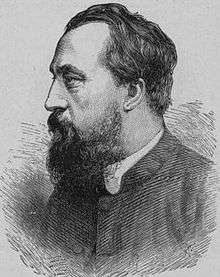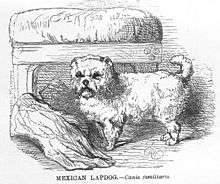John George Wood
John George Wood, or Rev J. G. Wood, (21 July 1827 – 3 March 1889), was an English writer who popularised natural history with his writings.[1]

Life and work
Early life and ordination
Wood was born in London, son of the surgeon John Freeman Wood and Juliana Lisetta. He was educated at home, at Ashbourne grammar school and Merton College, Oxford (B.A., 1848, M.A., 1851), and then at Christ Church, where he worked for some time in the anatomical museum under Sir Henry Acland. In 1852 he became curate of the parish of St Thomas the Martyr, Oxford, and in 1854 was ordained priest; he also took up the post of chaplain to the Boatmen's Floating Chapel at Oxford. Among other benefices which he held, he was for a time chaplain to St. Bartholomew's Hospital. In 1878 Wood settled in Upper Norwood, where he lived until his death.
Parson-naturalist
In 1854, Wood gave up his curacy to devote himself to writing on natural history, becoming a well-known parson-naturalist of the Victorian era.[2] However, he continued to take on priestly work, as in 1858 he accepted a readership at Christ Church, Newgate Street, and was assistant-chaplain to St Bartholomew's Hospital, London, from 1856 until 1862. Between 1868 and 1876 he was precentor to the Canterbury Diocesan Choral Union.
After 1876 he devoted himself to the production of books and lecturing on zoology, which he illustrated by drawing on a black-board or on large sheets of white paper with coloured crayons. These "sketch lectures," as he called them, were very popular, and made his name widely known both in Great Britain and in the United States.
Wood gave occasional lectures from 1856. In 1879, however, he began lecturing as a second profession, and continued to lecture steadily until 1888 in the United Kingdom and elsewhere. He delivered the Lowell Lectures in Boston, Massachusetts, in 1883-4.
Natural history populariser

Wood was a prolific and successful natural history writer, though rather as a populariser than as a scientist. For example, his book Common objects of the country sold 100,000 copies in a week. Among his works are Common Objects of the Microscope; Illustrated Natural History (1853); Animal Traits and Characteristics (1860); Common Objects of the Sea Shore (1857); The Uncivilized Races, or Natural History of Man (1868) (to which Mark Twain refers in his humorous work Roughing It);[3] Out of Doors[4] (1874) (a book that was quoted by Sir Arthur Conan Doyle in his Sherlock Holmes story "The Adventure of the Lion's Mane"); Field Naturalist's Handbook (with T. Wood) (1879–80); books on gymnastics and sport; and an edition of Gilbert White's Natural History of Selborne. He also edited The Boys Own Magazine.
Wood died at Coventry on 3 March 1889.
Works
- Sketches and Anecdotes of Animal Life (1856)
- Bees; Their habits, Management and Treatment (1860)
- Common Objects of the Microscope (1861)
- The Common Objects of the Country (1866)
- Insects abroad (1874)
- Insects at Home (1876)
- Nature's Teachings (1877)
- Bible Animals (1883)
- Hardy Perennials and Old Fashioned Flowers (1884)
- Popular Natural History (1885)
- Story of the Bible Animals (1888)
- Natural History (1894)
References
- Woodward, Bernard Barham (1900). . In Lee, Sidney (ed.). Dictionary of National Biography. 62. London: Smith, Elder & Co.
- Knight, David (2006). Public Understanding of Science: A History of Communicating Scientific Ideas. Routledge. p. 187.
- Twain, Mark (1 November 2013) [First published in 1872]. "Chapter XIX. Roughing it". University of Virginia Library.
Indeed, I have been obliged to look the bulky volumes of Wood's "Uncivilized Races of Men [sic] clear through in order to find a savage tribe degraded enough to take rank with the Goshoots. I find but one people fairly open to that shameful verdict. It is the Bosjesmans (Bushmen) of South Africa.... The Bushmen and our Goshoots are manifestly descended from the self-same gorilla, or kangaroo, or Norway rat, whichever animal-Adam the Darwinians trace them to.
- Wood, John George (1 January 1874). Out of Doors: A Selection of Original Articles on Practical Natural History. Longmans, Green, and Company – via Internet Archive.
Sources


- Whittington-Egan, Richard (2014). The Natural History Man: A Life of the Reverend J. G. Wood. Cappella Archive, Malvern. ISBN 9781-902918-60-0.
External links
![]()
- Works by John George Wood at Project Gutenberg
- Works by or about John George Wood at Internet Archive
- Whipple Library, Cambridge University
- Wood, J. G. — Biodiversity Heritage Library
- The Rev. J. G. Wood; his life and work. By the Rev. Theodore Wood.
- Sketches and Anecdotes of Animal Life by J. G. Wood with illustrations by Harrison Weir
- "A Blackberry Bush in Autumn". The Dark Blue. IV.: 159–168. September 1873 – February 1873.